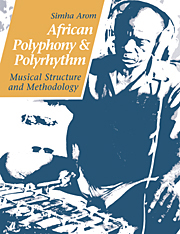Book contents
- Frontmatter
- Contents
- List of illustrations
- Foreword by György Ligeti
- Preface
- Acknowledgements
- BOOK I THE MUSIC OF THE CENTRAL AFRICAN REPUBLIC
- BOOK II AFRICAN POLYPHONIC MUSIC
- BOOK III TECHNICAL TOOLS: METHODS OF RECORDING POLYPHONIC MUSIC FOR TRANSCRIPTION
- BOOK IV THEORETICAL TOOLS
- BOOK V THE ORGANISATION OF TIME IN AFRICAN MUSIC
- 1 A brief survey of Western rhythmics
- 2 Towards a precise terminology
- 3 African rhythmics
- BOOK VI STRUCTURAL PRINCIPLES AND THEIR APPLICATION
- Conclusion
- Bibliography
2 - Towards a precise terminology
Published online by Cambridge University Press: 27 January 2010
- Frontmatter
- Contents
- List of illustrations
- Foreword by György Ligeti
- Preface
- Acknowledgements
- BOOK I THE MUSIC OF THE CENTRAL AFRICAN REPUBLIC
- BOOK II AFRICAN POLYPHONIC MUSIC
- BOOK III TECHNICAL TOOLS: METHODS OF RECORDING POLYPHONIC MUSIC FOR TRANSCRIPTION
- BOOK IV THEORETICAL TOOLS
- BOOK V THE ORGANISATION OF TIME IN AFRICAN MUSIC
- 1 A brief survey of Western rhythmics
- 2 Towards a precise terminology
- 3 African rhythmics
- BOOK VI STRUCTURAL PRINCIPLES AND THEIR APPLICATION
- Conclusion
- Bibliography
Summary
INTRODUCTION
Our study of African rhythm and discovery of what we believe to be its basic features suggest there is a common denominator which can provide a link between African rhythm and the principles underlying the kind of rhythm practiced in the West. A critical examination of Western terminology has revealed a number of inherent contradictions but has also shown where they come from. We have seen that they are connected with the development of the idea of rhythm in the West. A short history of this development has helped us to understand this more clearly. We have found that, in Emmanuel's words, ‘the development of rhythmics is related to the development of language’(1926: III).
We have seen that the Indoeuropean languages which gave rise to Vedic poetry and later to Greek poetry had pitch accents and no stress. Their versification, the ‘verbal rhythmics’ which ‘stylises the rhythm of language’ (Emmanuel 1926: 106) and is therefore an intermediate stage between the unmeasured flow of speech and strictly proportional musical rhythm, was based only on the quantitative contrast of long and short syllables and not on dynamic intensity.
We should here recall that most African languages are tone languages and also have no stress. In such languages (cf. Book I, 2.2.5), the pitch of a syllable is a distinctive feature; the same syllable spoken on different pitches can change the meaning of the word containing it. Tones are to these languages as pitch accent was to Indoeuropean languages. In either one, stress may have an expressive role, but is unrelated to phonology, i.e., does not distinguish the meaning of words.
- Type
- Chapter
- Information
- African Polyphony and PolyrhythmMusical Structure and Methodology, pp. 200 - 205Publisher: Cambridge University PressPrint publication year: 1991



